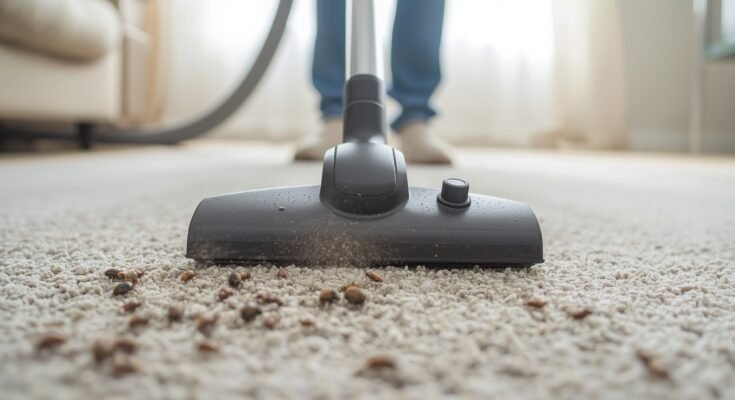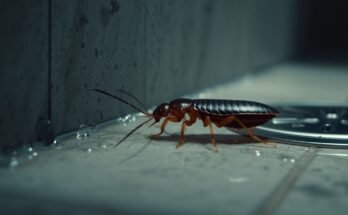Introduction
Finding holes in your carpet, clothes, or upholstery around your home is a clear sign that carpet beetles might have moved in. Despite their name, these tiny bugs don’t just live in carpets — they also feed on fabric, clothing, furs, and even stuffed specimens. From my experience dealing with pests in Australia, I’ve learned that both domestic and commercial properties, including retail stores and apartment units, can fall victim to these silent destroyers. The larvae, not the adults, cause most of the damage, chewing through household items such as bedsheets, curtains, and carpets. Over time, their infestations become a threat to your comfort, safety, and even your health.
These tiny critters are stubborn and can infest areas you’d least expect. Their shed skins or moult can lead to dermatitis, a condition that causes skin irritation, itchiness, and redness. Whether you suspect an infestation in your home or workspaces, this guide offers simple tips to help you clear the problem and protect your furniture and health from further destruction. Although they’re a nuisance with a notorious reputation, a bit of patience and regular cleaning can make your homes and workspaces feel immune again from these unwelcome guests.
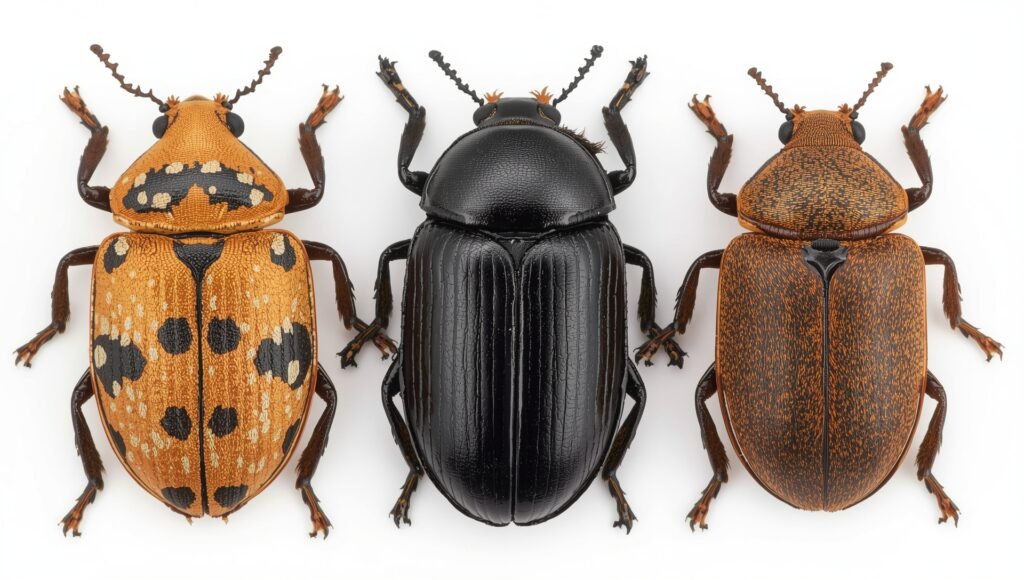
What Do Carpet Beetles Look Like? What Types of Carpet Beetles Are There?
When I first discovered carpet beetles in my home, I was surprised by how small they were — almost like tiny furry caterpillars. The larvae, often called woolly bear, have a banded appearance covered in short bristles and grow up to about 5mm long. Once these grown beetles emerge, their round shape, six legs, and fine antennae make them easy to recognize. Among the common species, varied carpet beetles or variegated carpet beetles display a mix of colours — orange, black, and white, sometimes in a speckled pattern. They measure roughly 2mm to 4mm in length. On the other hand, black carpet beetles are distinct, being completely all-black in colour, which perfectly fits their name.
What Is a Carpet Beetle?
Each species of carpet beetle has a length ranging between 1mm and 4mm, with an oval body and wavy color patterns that can include white, black, yellow, or orange. In spring, a female can lay anywhere from 25 to 100 eggs, which hatch into larvae within two weeks. This insect tends to feed on fabric and animal products, and the adults often fly into your home through an open door or window. Once inside, they lay eggs on furniture, carpets, curtains, and clothes. Sometimes, they can even be infested within plants and flowers, making them tricky to spot before the problem spreads.
What Are the Risks of Having a Carpet Beetle in the House?
These tiny creatures may seem harmless, but they can be incredibly annoying once they invade your home. Their larvae love to eat natural fibers such as wool, feathers, clothing, silk, animal hair, and leather, often causing visible holes and damage to your furniture. Some people even develop an allergy to larval bristles, which can irritate the skin and cause discomfort. While adult beetles prefer seeds, plants, and flowers, their younger stage is what causes the most trouble indoors.
How Do I Get Rid of Carpet Beetles?
To eliminate these pests, start by washing and drying furniture and clothes before storing them for long periods—this kills any eggs. You can also try freezing fabric for about two weeks. Store items in locked cabinets, and check them from time to time. Use a vacuum cleaner to clean carpets, rugs, and furniture, making sure to pull out all debris for safe disposal of waste. Inspect your house, flowers, and silk for insects, and remove birds’ nests or millennial animals that may attract them. A gentle insecticide can help if used according to instructions—avoid spraying pesticides on fabrics. Many experts recommend diatomaceous earth, a dried substance that kills larvae by drying them out. If the home is severely damaged, a specialized team like Storm can assess the issue, find a solution, and eliminate insects or pests effectively through examination and a personalized, science-backed treatment plan tailored to your needs.
How Do You Get Carpet Beetles – Where Do They Come From?
Carpet beetles enter homes from multiple sources—through shopping, flowers, animal furs, skins, or stuffed specimens. They often arrive hidden in contaminated fabrics and furnishings, making it easy for them to spread unnoticed throughout your home.
What Causes Carpet Beetles?
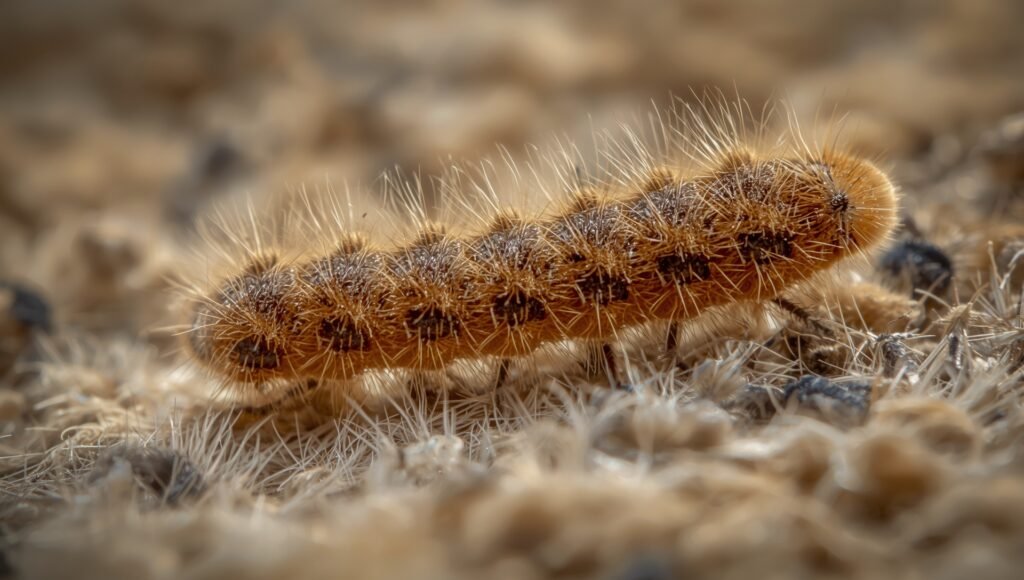
Having carpet beetles can be a matter of bad luck, especially if you have a dirty carpet. They thrive on hair, dead insects, and dead skin, turning your floor into a perfect banquet if you neglect to vacuum regularly.
How Do Carpet Beetles Spread?
These pests lay eggs on larval food derived from animal origin, like woollen carpets, clothing, furs, and museum specimens, where food is abundant. A single female can produce over 100 eggs, which hatch within 10 days to a month, quickly expanding the infestation.
Where Are Carpet Beetles Found?
You’ll often find them hiding in furnishings, carpet, curtains, cushions, or even potpourri. Surprisingly, they can infest dried pasta and pet biscuits too. When the root of the problem is hard to locate, it’s wise to contact a professional pest controller to stop the infestation from spreading further.
Can Carpet Beetles Harm Humans?
Though not directly harmful to humans, carpet beetles can cause rashes, bumpy skin, and reactions from their airborne fibres.
Do Carpet Beetles Bite – or Their Larvae?
Carpet beetles don’t bite people, and their woolly bear larvae don’t either. However, their rough hairs can cause rashes, irritation, and marks that resemble bites, making many think these carpet bugs are the pest responsible for real bites.
How To Get Rid Of Carpet Beetles?
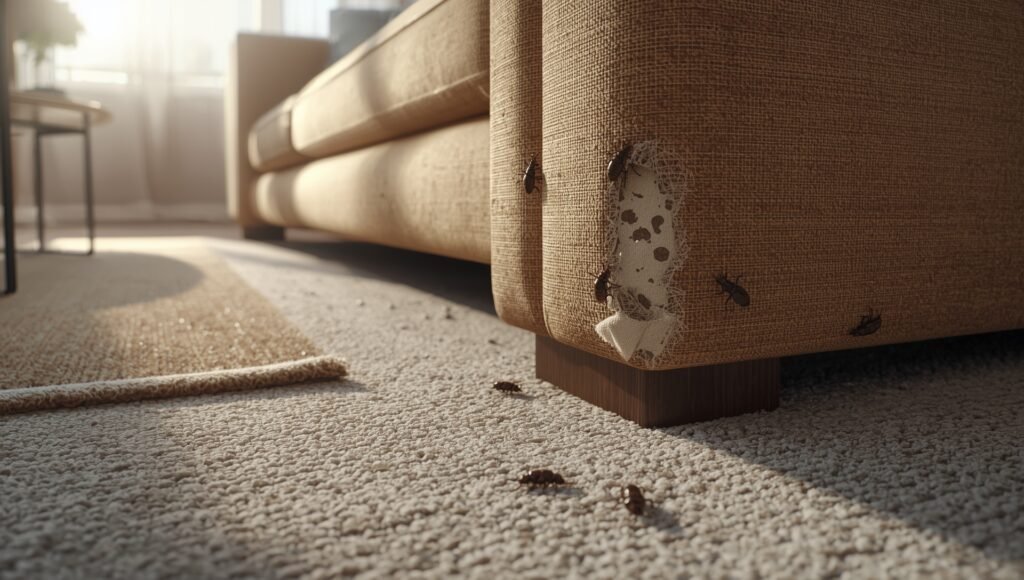
When a female carpet beetle lays up to 90 eggs, early detection becomes crucial for quick extermination. Whether you’re dealing with an infestation at home or in an office, having the right tips and experience can make all the difference. From my background in pest control, I’ve seen both domestic and commercial spaces face this problem—brands like Pestline often emphasize prevention as much as treatment. Keeping your environment clean and well-maintained helps stop carpet beetles before they spread.
1. Vacuum Regularly
Start by using a vacuum often, especially if you notice signs of a carpet beetle infestation. Focus on every room in your property, including carpet floors, under the bed, and behind furniture. These cool, damp places are common egg-laying spots. Vacuuming removes eggs, moult, and prevents dermatitis caused by beetle debris. Make sure to clean every centimetre to keep away pests like carpet mites and ants while maintaining a fresh, healthy home.
2. Wash and Store Your Clothes Properly
Carpet beetles prefer natural fabrics such as clothes made of wool or cotton. At home, machine wash them in hot water to kill eggs and larvae. For long-term storage, seal garments in vacuum-sealed bags to prevent infestation and keep them safe from damage.
3. Minimise Outdoor Lighting
Bright environments attract carpet beetles and other insects. Reducing outdoor lighting lowers the risk of drawing hordes of critters and moths toward your property. To avoid repeated infestations, minimise unnecessary lights around your home at night.
4. Use a Specialised Insecticide
If you find a carpet beetle infestation, spray all affected areas, such as carpets, bedsheets, and fabric curtains, using a safe insecticide. Be sure to target eggs effectively and follow directions carefully—keep food, pets, and children away during treatment. Always use products formulated specifically for this purpose to ensure safety and effectiveness.
5. Inspect New Plants for Carpet Beetles
Because carpet beetles feed on pollen and nectar, check flowers and plants before bringing them indoors. Always inspect for pests that might hitch a ride. Stopping them at the source prevents costly extermination measures later.
6. Clean Secondhand Furniture Thoroughly
Buying secondhand furniture can unknowingly bring carpet beetles or other unwanted guests. Before using pre-owned furniture such as beds, couches, or mattresses, inspect and clean them properly to prevent an outbreak. Wash fabrics in hot water and apply disinfectant to ensure everything stays beetle-free.
7. Install an Insect Screen
Adding an insect screen to your door and windows can prevent another infestation from recurring. If you live near a garden, forest, or park, this small step can prevent beetles from entering your home in the first place.
8. Enlist Professional Help
If the infestation grows beyond control, call professionals familiar with both domestic and commercial pest problems. A skilled exterminator uses the right extermination tools and proven pest management services to protect homes, businesses, and property. Trusted names like Pestline operate across Melbourne, Kingston, Cranbourne, and the CBD, and can offer a reliable quote for serious infestations.
Are Carpet Beetles Harmful/Dangerous or Safe?
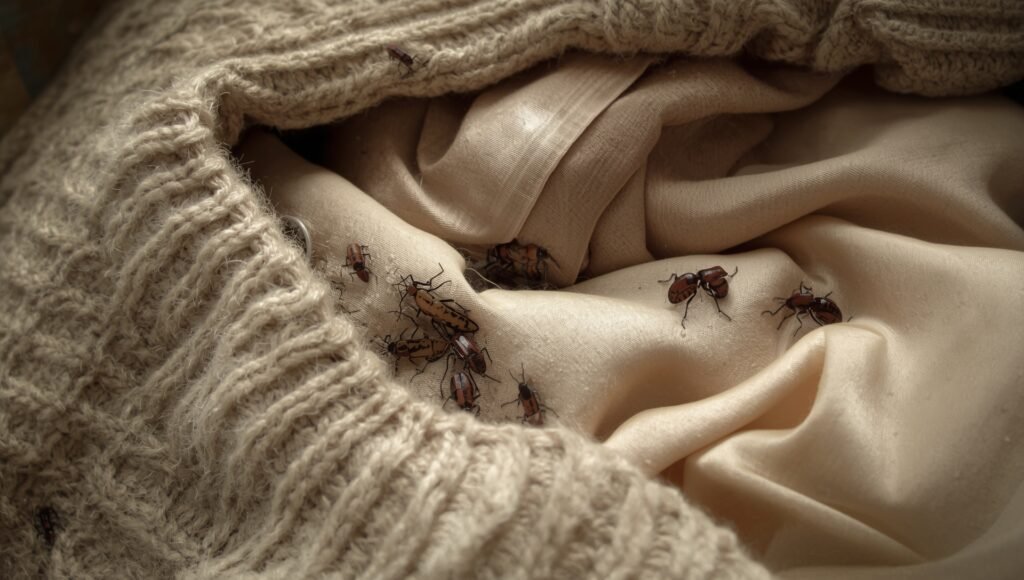
Although carpet beetles are not poisonous, they can still pose a minor health concern for some people. Their tiny hairs and shed particles may irritate the respiratory tract or cause eye irritation if the problem is left untreated for a long time. The good news is that by treating the issue early, you can prevent any discomfort and keep your environment safe. Overall, while these pests can be harmful to fabrics and materials, they aren’t dangerous to humans.
How Do You Prevent Carpet Beetles?
To stop an infestation before it begins, make sure to clean your home regularly and thoroughly. Store all food in sealed containers, and use bug nets over windows and doors to block entry. Before bringing plants and flowers indoors, inspect them carefully. Also, seal any cracks or gaps that could serve as access points for carpet beetles.
How To Get Rid Of Carpet Beetles
If carpet beetles have already taken hold, start by cleaning all infested areas using a nozzle vacuum cleaner to remove debris, larvae, and dirt from cracks and crevices. Apply a residual insecticide afterward, as well as dust formulations or desiccant dusts to target spots that can’t be easily vacuumed during routine cleaning. For complete and permanent results, it’s best to consult a licensed pest control expert, such as Pest Defence, who can perform a professional treatment. Reputable pest control companies know how to handle an infestation safely and use the most effective and safest methods to kill both beetles and woolly bear larvae.
Can Carpet Beetles Fly?
Yes, carpet beetles can fly, allowing them to enter your home through open windows. Their mobility makes them a nuisance and helps them spread easily around the house once inside.
Do Carpet Beetles Have Wings?
When carpet beetles reach maturity, they develop wings and are able to fly, which is why preventing entry in the first place is so important.
Conclusion
Carpet beetles can be persistent pests, but with the right approach, they can be effectively controlled. Regular cleaning, proper storage of fabrics, and maintaining good household hygiene are key to preventing infestations. Early detection makes removal much easier and helps protect your furniture, clothing, and overall indoor environment. If an infestation becomes difficult to manage, seeking guidance from a qualified pest control professional ensures the safest and most effective treatment. Taking proactive steps today
FAQ’s
1-What Do Carpet Beetles Eat?
Carpet beetles feed on a wide range of organic materials found in the home.
- Wood: Yes, they can eat wood.
- Clothes: Yes, especially natural fibers.
- Cotton: Yes.
- Books: Yes.
- Leather: Yes.
Essentially, carpet beetles consume most organic matter. Because they can fly, they easily spread across different fabrics and materials throughout your home. The only materials they rarely eat are synthetic fabrics.
2-Where Do Carpet Beetles Lay Their Eggs?
Carpet beetles lay their eggs indoors, typically in dark, hidden areas such as carpet corners, skirting boards, and beneath furniture.
3-What Is the Life Cycle of a Carpet Beetle?
The life cycle of a carpet beetle lasts several weeks.
- Egg stage: Eggs hatch within 7–28 days.
- Larvae: Appear as small, hairy worms before pupating.
- Pupae to adult: The adult beetle lives for about 2–3 weeks once it matures.
In total, the complete life cycle typically lasts 3–4 weeks.
4-How Long Do Carpet Beetles Live?
Adult carpet beetles live for approximately 3 to 4 weeks.
5-Can You Freeze Carpet Beetles?
Yes. Carpet beetles and their eggs will die from temperature shock if exposed to extreme cold. Place any infested items inside a sealed freezer bag and freeze them to eliminate beetles from your furnishings.
6-Will Carpet Beetles Die in the Washing Machine?
Yes. Washing infested clothes at a high temperature will kill carpet beetles, larvae, and eggs.
7-Do Carpet Beetles Die in Winter?
Not necessarily. Eggs laid in late summer often hatch in winter, and the larvae remain indoors where it’s warm until spring.
8-What Colour Are Carpet Beetle Eggs?
Carpet beetle eggs are white or cream-colored, measuring around ¼ to ½ millimeters in length.
9-Do Carpet Beetles Shed Their Skin?
Yes. As they grow, carpet beetle larvae shed their outer casing (moult), leaving small, dry shells behind.
10-Why Are Carpet Beetles in My Bed?
Carpet beetles are often mistaken for bed bugs, but they don’t typically live in beds. They may occasionally appear there if natural fabrics are present.
11-Why Are Carpet Beetles in My Kitchen?
Carpet beetles may infest kitchens if they find food sources like flour, grains, or dried pasta. Keeping all food in airtight containers helps prevent infestations.
12-Carpet Beetles in My Car
Car interiors often provide ideal conditions for carpet beetles. Leather seats, floor mats, and dust attract them.
To eliminate carpet beetles from your car:
- Vacuum thoroughly.
- Apply boric acid to mats.
- Steam clean the seats and carpets.

